Global Health Equity and Human Rights: Coal Mine Impact Analysis
VerifiedAdded on 2022/11/17
|14
|3756
|133
Report
AI Summary
This report examines the detrimental health effects of coal mines in the USA, specifically focusing on chronic obstructive pulmonary disease (COPD) caused by air pollution. It highlights the violation of human rights, particularly the right to health, due to unregulated coal combustion. The report proposes a rights-based approach, incorporating the Human Rights Based Approach (HRBA), to address these issues. The strategy involves empowering affected communities through education on health risks and pollution, and implementing accountability measures for governmental and non-governmental organizations to provide resources such as face masks. The report outlines implementation and monitoring plans, addressing barriers to ensure sustainability and evaluation of the strategy's effectiveness in reducing pollution and improving health outcomes. The strategy aims to reduce exposure to pollutants and mitigate the risks of respiratory diseases in vulnerable populations, aligning with international human rights standards and promoting health equity.
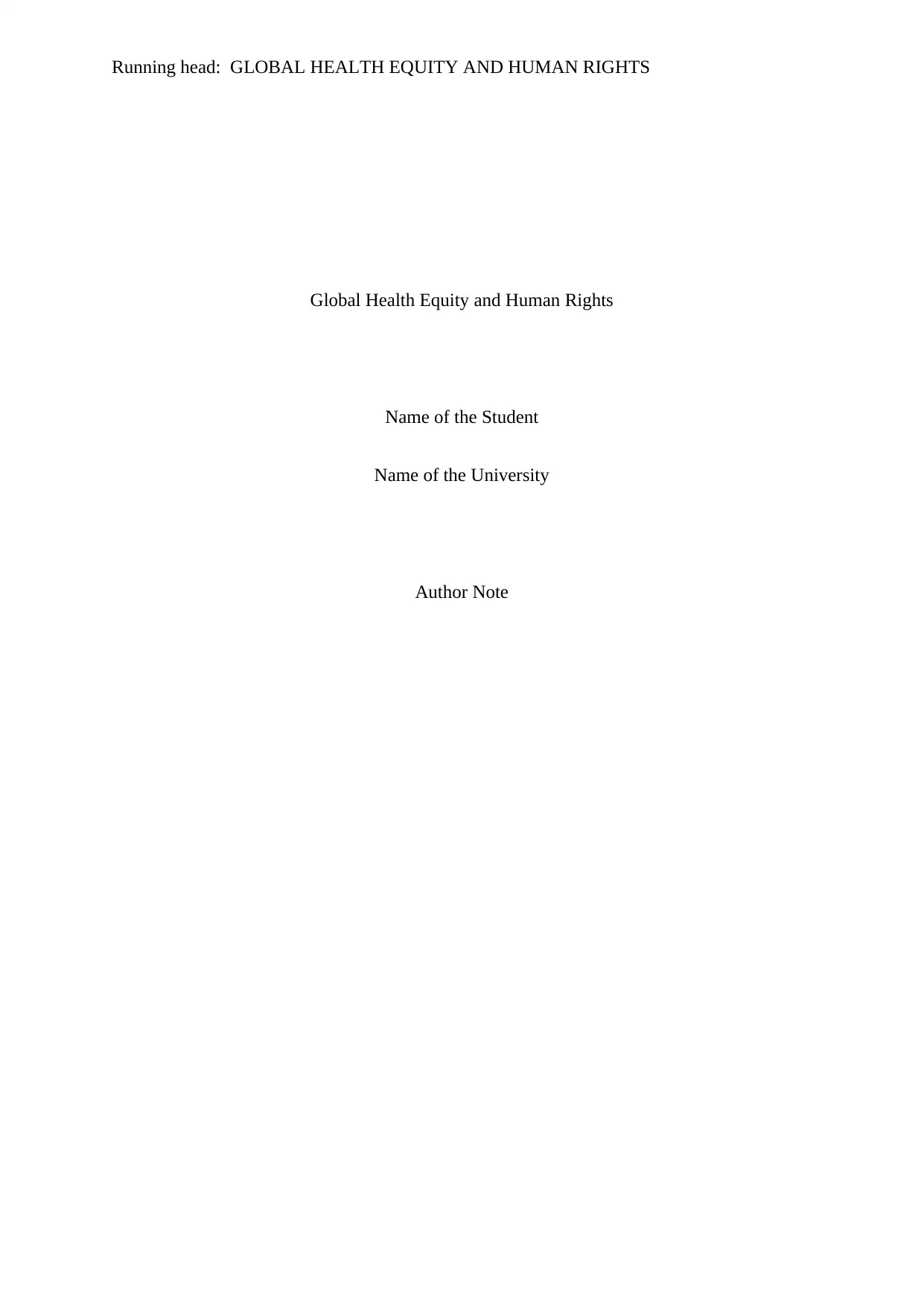
Running head: GLOBAL HEALTH EQUITY AND HUMAN RIGHTS
Global Health Equity and Human Rights
Name of the Student
Name of the University
Author Note
Global Health Equity and Human Rights
Name of the Student
Name of the University
Author Note
Paraphrase This Document
Need a fresh take? Get an instant paraphrase of this document with our AI Paraphraser
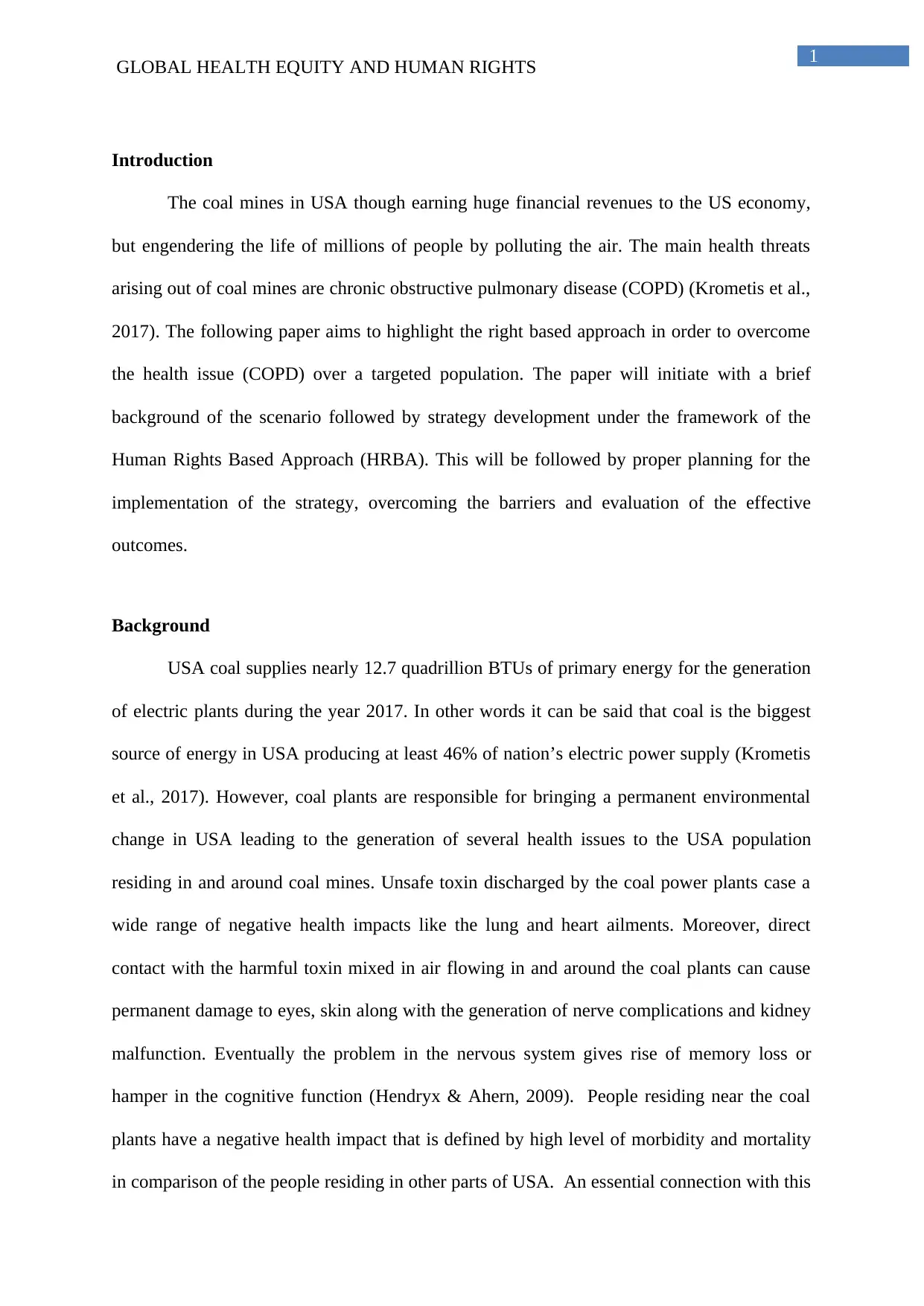
1
GLOBAL HEALTH EQUITY AND HUMAN RIGHTS
Introduction
The coal mines in USA though earning huge financial revenues to the US economy,
but engendering the life of millions of people by polluting the air. The main health threats
arising out of coal mines are chronic obstructive pulmonary disease (COPD) (Krometis et al.,
2017). The following paper aims to highlight the right based approach in order to overcome
the health issue (COPD) over a targeted population. The paper will initiate with a brief
background of the scenario followed by strategy development under the framework of the
Human Rights Based Approach (HRBA). This will be followed by proper planning for the
implementation of the strategy, overcoming the barriers and evaluation of the effective
outcomes.
Background
USA coal supplies nearly 12.7 quadrillion BTUs of primary energy for the generation
of electric plants during the year 2017. In other words it can be said that coal is the biggest
source of energy in USA producing at least 46% of nation’s electric power supply (Krometis
et al., 2017). However, coal plants are responsible for bringing a permanent environmental
change in USA leading to the generation of several health issues to the USA population
residing in and around coal mines. Unsafe toxin discharged by the coal power plants case a
wide range of negative health impacts like the lung and heart ailments. Moreover, direct
contact with the harmful toxin mixed in air flowing in and around the coal plants can cause
permanent damage to eyes, skin along with the generation of nerve complications and kidney
malfunction. Eventually the problem in the nervous system gives rise of memory loss or
hamper in the cognitive function (Hendryx & Ahern, 2009). People residing near the coal
plants have a negative health impact that is defined by high level of morbidity and mortality
in comparison of the people residing in other parts of USA. An essential connection with this
GLOBAL HEALTH EQUITY AND HUMAN RIGHTS
Introduction
The coal mines in USA though earning huge financial revenues to the US economy,
but engendering the life of millions of people by polluting the air. The main health threats
arising out of coal mines are chronic obstructive pulmonary disease (COPD) (Krometis et al.,
2017). The following paper aims to highlight the right based approach in order to overcome
the health issue (COPD) over a targeted population. The paper will initiate with a brief
background of the scenario followed by strategy development under the framework of the
Human Rights Based Approach (HRBA). This will be followed by proper planning for the
implementation of the strategy, overcoming the barriers and evaluation of the effective
outcomes.
Background
USA coal supplies nearly 12.7 quadrillion BTUs of primary energy for the generation
of electric plants during the year 2017. In other words it can be said that coal is the biggest
source of energy in USA producing at least 46% of nation’s electric power supply (Krometis
et al., 2017). However, coal plants are responsible for bringing a permanent environmental
change in USA leading to the generation of several health issues to the USA population
residing in and around coal mines. Unsafe toxin discharged by the coal power plants case a
wide range of negative health impacts like the lung and heart ailments. Moreover, direct
contact with the harmful toxin mixed in air flowing in and around the coal plants can cause
permanent damage to eyes, skin along with the generation of nerve complications and kidney
malfunction. Eventually the problem in the nervous system gives rise of memory loss or
hamper in the cognitive function (Hendryx & Ahern, 2009). People residing near the coal
plants have a negative health impact that is defined by high level of morbidity and mortality
in comparison of the people residing in other parts of USA. An essential connection with this
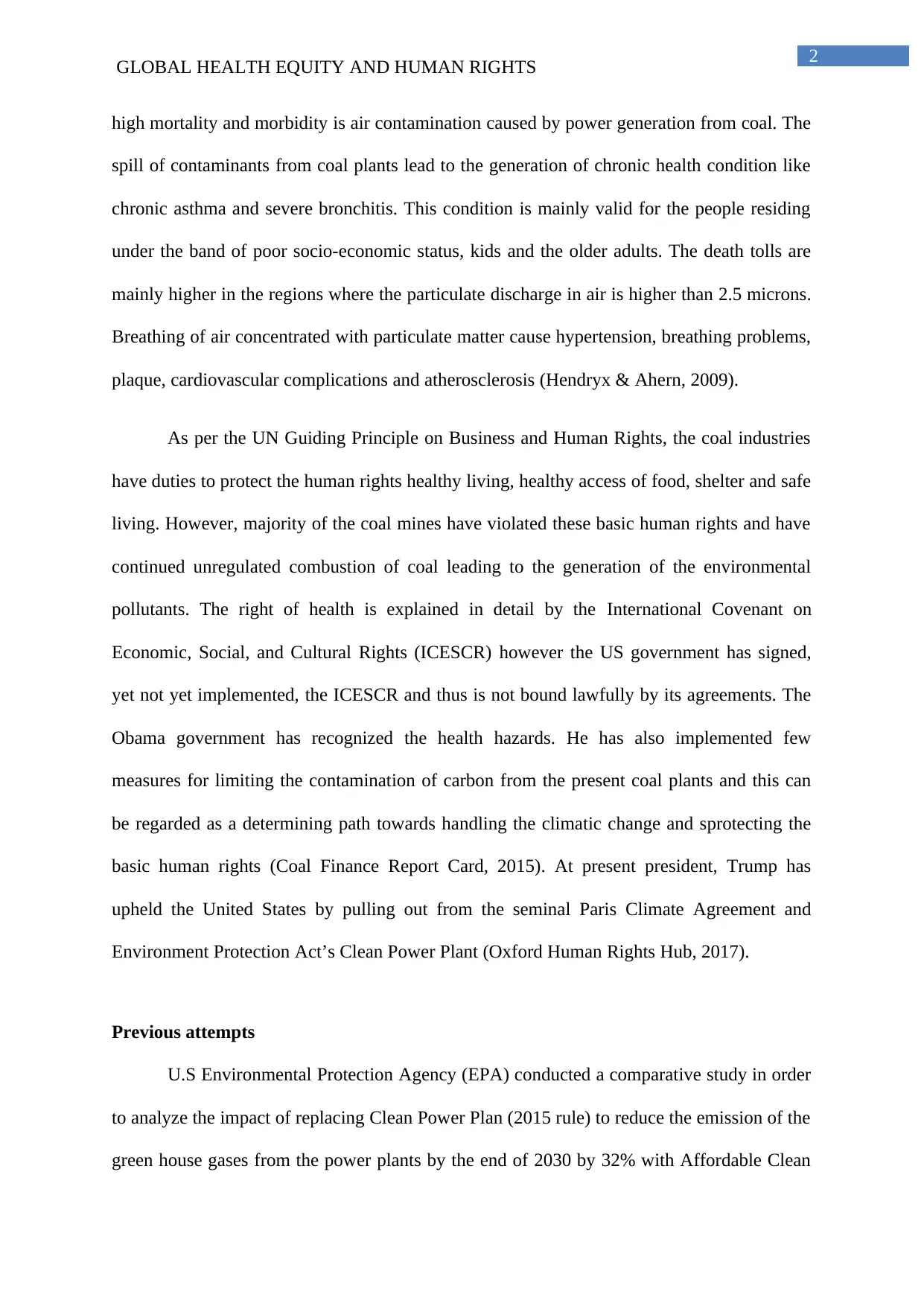
2
GLOBAL HEALTH EQUITY AND HUMAN RIGHTS
high mortality and morbidity is air contamination caused by power generation from coal. The
spill of contaminants from coal plants lead to the generation of chronic health condition like
chronic asthma and severe bronchitis. This condition is mainly valid for the people residing
under the band of poor socio-economic status, kids and the older adults. The death tolls are
mainly higher in the regions where the particulate discharge in air is higher than 2.5 microns.
Breathing of air concentrated with particulate matter cause hypertension, breathing problems,
plaque, cardiovascular complications and atherosclerosis (Hendryx & Ahern, 2009).
As per the UN Guiding Principle on Business and Human Rights, the coal industries
have duties to protect the human rights healthy living, healthy access of food, shelter and safe
living. However, majority of the coal mines have violated these basic human rights and have
continued unregulated combustion of coal leading to the generation of the environmental
pollutants. The right of health is explained in detail by the International Covenant on
Economic, Social, and Cultural Rights (ICESCR) however the US government has signed,
yet not yet implemented, the ICESCR and thus is not bound lawfully by its agreements. The
Obama government has recognized the health hazards. He has also implemented few
measures for limiting the contamination of carbon from the present coal plants and this can
be regarded as a determining path towards handling the climatic change and sprotecting the
basic human rights (Coal Finance Report Card, 2015). At present president, Trump has
upheld the United States by pulling out from the seminal Paris Climate Agreement and
Environment Protection Act’s Clean Power Plant (Oxford Human Rights Hub, 2017).
Previous attempts
U.S Environmental Protection Agency (EPA) conducted a comparative study in order
to analyze the impact of replacing Clean Power Plan (2015 rule) to reduce the emission of the
green house gases from the power plants by the end of 2030 by 32% with Affordable Clean
GLOBAL HEALTH EQUITY AND HUMAN RIGHTS
high mortality and morbidity is air contamination caused by power generation from coal. The
spill of contaminants from coal plants lead to the generation of chronic health condition like
chronic asthma and severe bronchitis. This condition is mainly valid for the people residing
under the band of poor socio-economic status, kids and the older adults. The death tolls are
mainly higher in the regions where the particulate discharge in air is higher than 2.5 microns.
Breathing of air concentrated with particulate matter cause hypertension, breathing problems,
plaque, cardiovascular complications and atherosclerosis (Hendryx & Ahern, 2009).
As per the UN Guiding Principle on Business and Human Rights, the coal industries
have duties to protect the human rights healthy living, healthy access of food, shelter and safe
living. However, majority of the coal mines have violated these basic human rights and have
continued unregulated combustion of coal leading to the generation of the environmental
pollutants. The right of health is explained in detail by the International Covenant on
Economic, Social, and Cultural Rights (ICESCR) however the US government has signed,
yet not yet implemented, the ICESCR and thus is not bound lawfully by its agreements. The
Obama government has recognized the health hazards. He has also implemented few
measures for limiting the contamination of carbon from the present coal plants and this can
be regarded as a determining path towards handling the climatic change and sprotecting the
basic human rights (Coal Finance Report Card, 2015). At present president, Trump has
upheld the United States by pulling out from the seminal Paris Climate Agreement and
Environment Protection Act’s Clean Power Plant (Oxford Human Rights Hub, 2017).
Previous attempts
U.S Environmental Protection Agency (EPA) conducted a comparative study in order
to analyze the impact of replacing Clean Power Plan (2015 rule) to reduce the emission of the
green house gases from the power plants by the end of 2030 by 32% with Affordable Clean
⊘ This is a preview!⊘
Do you want full access?
Subscribe today to unlock all pages.

Trusted by 1+ million students worldwide
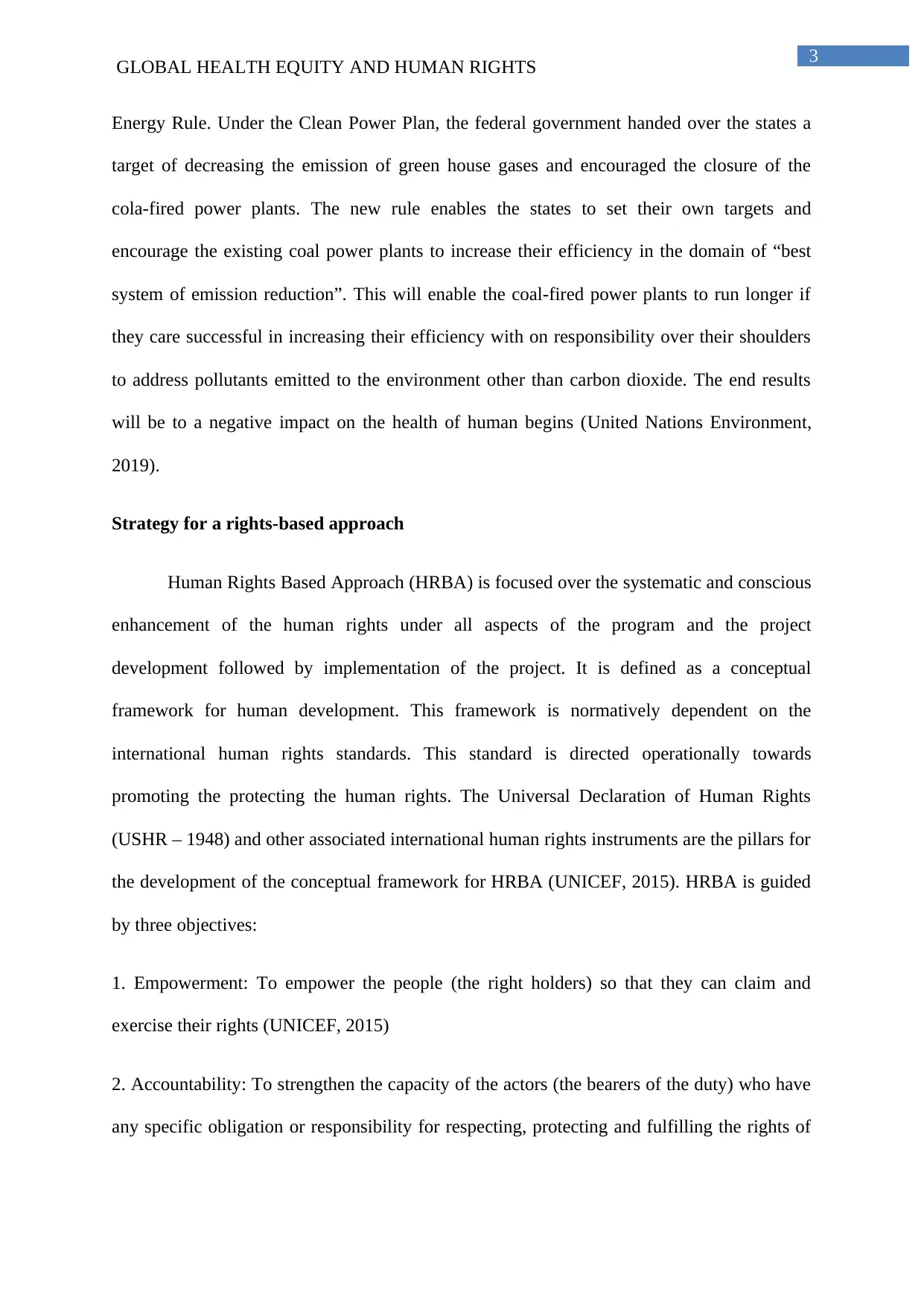
3
GLOBAL HEALTH EQUITY AND HUMAN RIGHTS
Energy Rule. Under the Clean Power Plan, the federal government handed over the states a
target of decreasing the emission of green house gases and encouraged the closure of the
cola-fired power plants. The new rule enables the states to set their own targets and
encourage the existing coal power plants to increase their efficiency in the domain of “best
system of emission reduction”. This will enable the coal-fired power plants to run longer if
they care successful in increasing their efficiency with on responsibility over their shoulders
to address pollutants emitted to the environment other than carbon dioxide. The end results
will be to a negative impact on the health of human begins (United Nations Environment,
2019).
Strategy for a rights-based approach
Human Rights Based Approach (HRBA) is focused over the systematic and conscious
enhancement of the human rights under all aspects of the program and the project
development followed by implementation of the project. It is defined as a conceptual
framework for human development. This framework is normatively dependent on the
international human rights standards. This standard is directed operationally towards
promoting the protecting the human rights. The Universal Declaration of Human Rights
(USHR – 1948) and other associated international human rights instruments are the pillars for
the development of the conceptual framework for HRBA (UNICEF, 2015). HRBA is guided
by three objectives:
1. Empowerment: To empower the people (the right holders) so that they can claim and
exercise their rights (UNICEF, 2015)
2. Accountability: To strengthen the capacity of the actors (the bearers of the duty) who have
any specific obligation or responsibility for respecting, protecting and fulfilling the rights of
GLOBAL HEALTH EQUITY AND HUMAN RIGHTS
Energy Rule. Under the Clean Power Plan, the federal government handed over the states a
target of decreasing the emission of green house gases and encouraged the closure of the
cola-fired power plants. The new rule enables the states to set their own targets and
encourage the existing coal power plants to increase their efficiency in the domain of “best
system of emission reduction”. This will enable the coal-fired power plants to run longer if
they care successful in increasing their efficiency with on responsibility over their shoulders
to address pollutants emitted to the environment other than carbon dioxide. The end results
will be to a negative impact on the health of human begins (United Nations Environment,
2019).
Strategy for a rights-based approach
Human Rights Based Approach (HRBA) is focused over the systematic and conscious
enhancement of the human rights under all aspects of the program and the project
development followed by implementation of the project. It is defined as a conceptual
framework for human development. This framework is normatively dependent on the
international human rights standards. This standard is directed operationally towards
promoting the protecting the human rights. The Universal Declaration of Human Rights
(USHR – 1948) and other associated international human rights instruments are the pillars for
the development of the conceptual framework for HRBA (UNICEF, 2015). HRBA is guided
by three objectives:
1. Empowerment: To empower the people (the right holders) so that they can claim and
exercise their rights (UNICEF, 2015)
2. Accountability: To strengthen the capacity of the actors (the bearers of the duty) who have
any specific obligation or responsibility for respecting, protecting and fulfilling the rights of
Paraphrase This Document
Need a fresh take? Get an instant paraphrase of this document with our AI Paraphraser
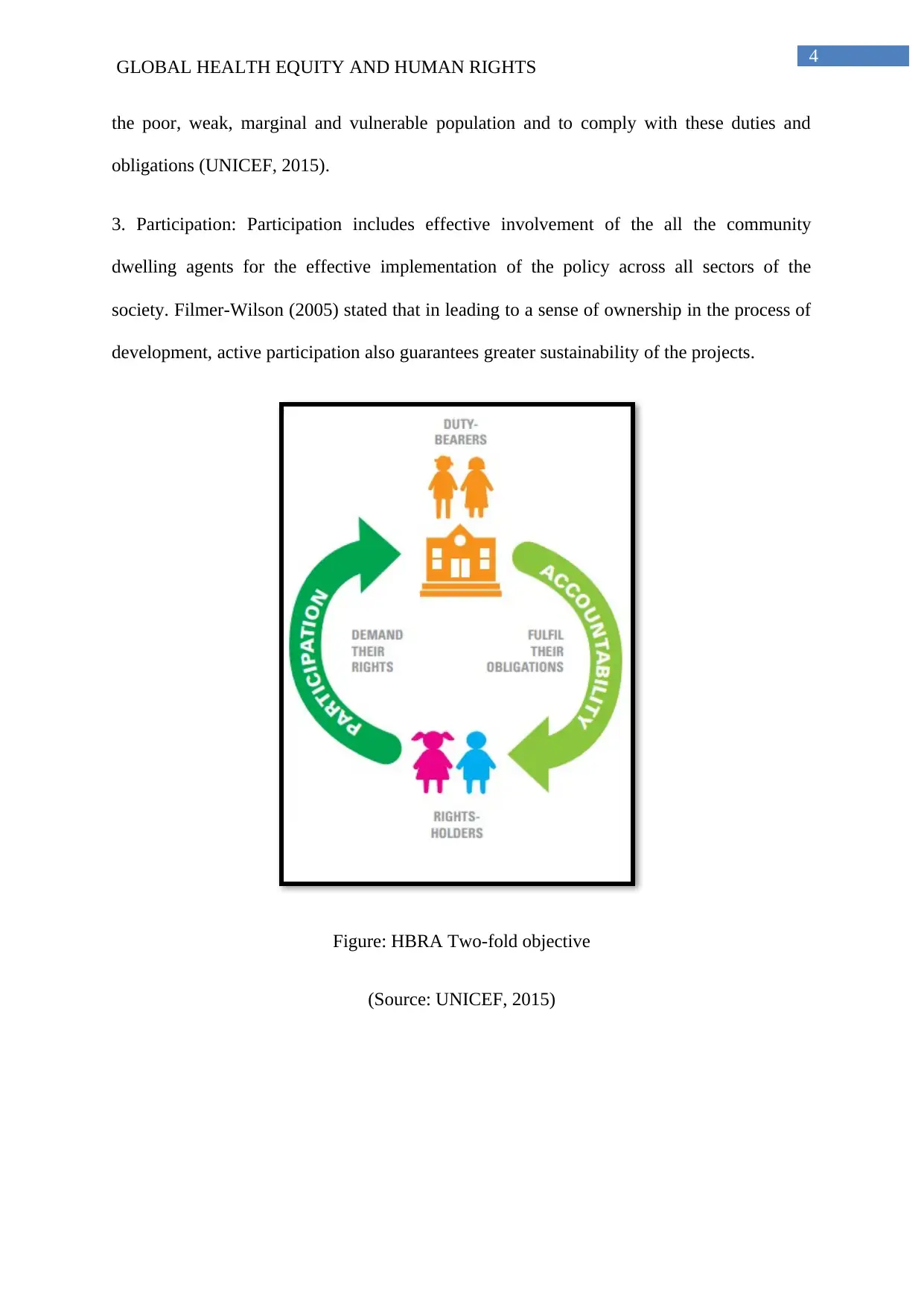
4
GLOBAL HEALTH EQUITY AND HUMAN RIGHTS
the poor, weak, marginal and vulnerable population and to comply with these duties and
obligations (UNICEF, 2015).
3. Participation: Participation includes effective involvement of the all the community
dwelling agents for the effective implementation of the policy across all sectors of the
society. Filmer-Wilson (2005) stated that in leading to a sense of ownership in the process of
development, active participation also guarantees greater sustainability of the projects.
Figure: HBRA Two-fold objective
(Source: UNICEF, 2015)
GLOBAL HEALTH EQUITY AND HUMAN RIGHTS
the poor, weak, marginal and vulnerable population and to comply with these duties and
obligations (UNICEF, 2015).
3. Participation: Participation includes effective involvement of the all the community
dwelling agents for the effective implementation of the policy across all sectors of the
society. Filmer-Wilson (2005) stated that in leading to a sense of ownership in the process of
development, active participation also guarantees greater sustainability of the projects.
Figure: HBRA Two-fold objective
(Source: UNICEF, 2015)
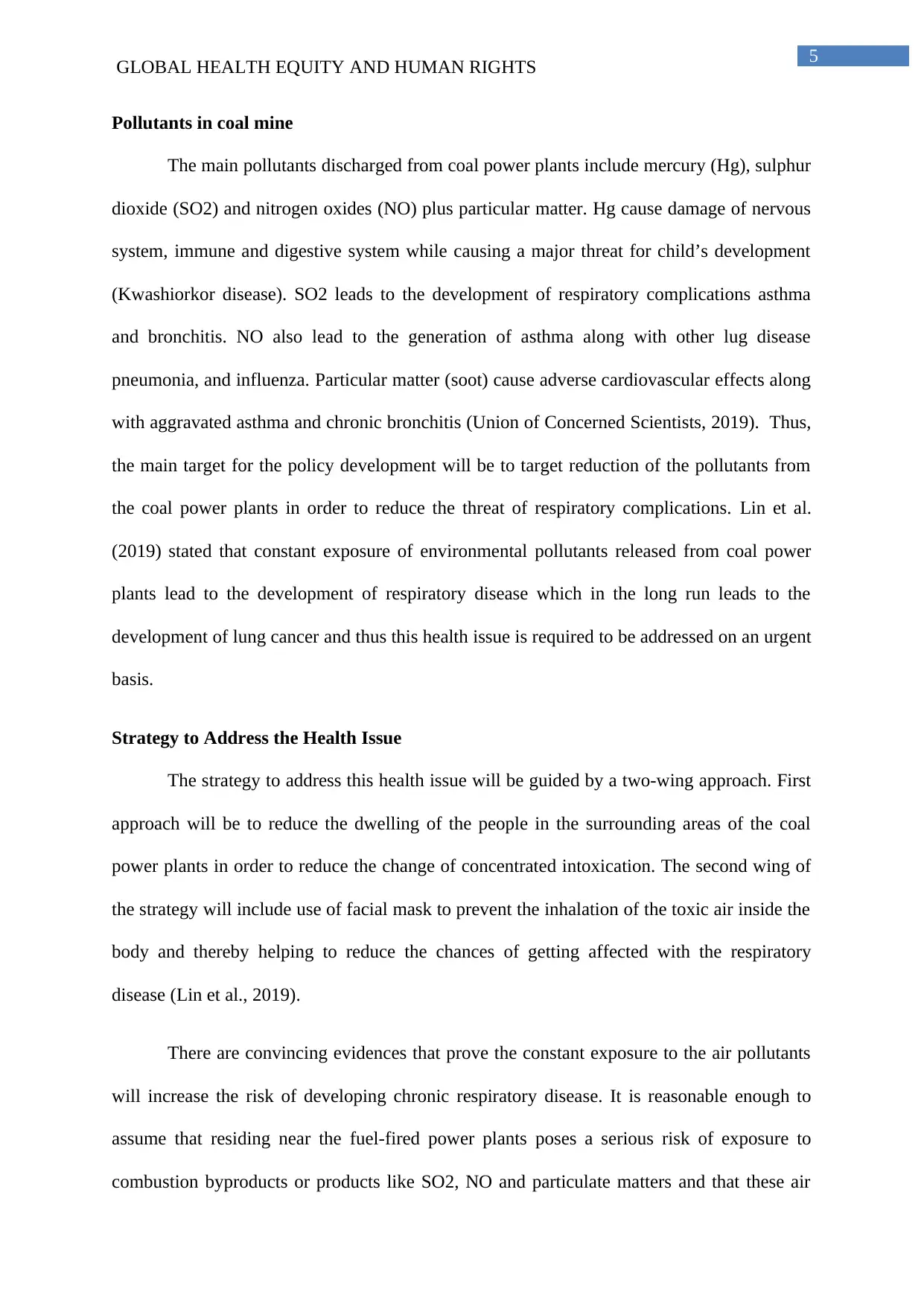
5
GLOBAL HEALTH EQUITY AND HUMAN RIGHTS
Pollutants in coal mine
The main pollutants discharged from coal power plants include mercury (Hg), sulphur
dioxide (SO2) and nitrogen oxides (NO) plus particular matter. Hg cause damage of nervous
system, immune and digestive system while causing a major threat for child’s development
(Kwashiorkor disease). SO2 leads to the development of respiratory complications asthma
and bronchitis. NO also lead to the generation of asthma along with other lug disease
pneumonia, and influenza. Particular matter (soot) cause adverse cardiovascular effects along
with aggravated asthma and chronic bronchitis (Union of Concerned Scientists, 2019). Thus,
the main target for the policy development will be to target reduction of the pollutants from
the coal power plants in order to reduce the threat of respiratory complications. Lin et al.
(2019) stated that constant exposure of environmental pollutants released from coal power
plants lead to the development of respiratory disease which in the long run leads to the
development of lung cancer and thus this health issue is required to be addressed on an urgent
basis.
Strategy to Address the Health Issue
The strategy to address this health issue will be guided by a two-wing approach. First
approach will be to reduce the dwelling of the people in the surrounding areas of the coal
power plants in order to reduce the change of concentrated intoxication. The second wing of
the strategy will include use of facial mask to prevent the inhalation of the toxic air inside the
body and thereby helping to reduce the chances of getting affected with the respiratory
disease (Lin et al., 2019).
There are convincing evidences that prove the constant exposure to the air pollutants
will increase the risk of developing chronic respiratory disease. It is reasonable enough to
assume that residing near the fuel-fired power plants poses a serious risk of exposure to
combustion byproducts or products like SO2, NO and particulate matters and that these air
GLOBAL HEALTH EQUITY AND HUMAN RIGHTS
Pollutants in coal mine
The main pollutants discharged from coal power plants include mercury (Hg), sulphur
dioxide (SO2) and nitrogen oxides (NO) plus particular matter. Hg cause damage of nervous
system, immune and digestive system while causing a major threat for child’s development
(Kwashiorkor disease). SO2 leads to the development of respiratory complications asthma
and bronchitis. NO also lead to the generation of asthma along with other lug disease
pneumonia, and influenza. Particular matter (soot) cause adverse cardiovascular effects along
with aggravated asthma and chronic bronchitis (Union of Concerned Scientists, 2019). Thus,
the main target for the policy development will be to target reduction of the pollutants from
the coal power plants in order to reduce the threat of respiratory complications. Lin et al.
(2019) stated that constant exposure of environmental pollutants released from coal power
plants lead to the development of respiratory disease which in the long run leads to the
development of lung cancer and thus this health issue is required to be addressed on an urgent
basis.
Strategy to Address the Health Issue
The strategy to address this health issue will be guided by a two-wing approach. First
approach will be to reduce the dwelling of the people in the surrounding areas of the coal
power plants in order to reduce the change of concentrated intoxication. The second wing of
the strategy will include use of facial mask to prevent the inhalation of the toxic air inside the
body and thereby helping to reduce the chances of getting affected with the respiratory
disease (Lin et al., 2019).
There are convincing evidences that prove the constant exposure to the air pollutants
will increase the risk of developing chronic respiratory disease. It is reasonable enough to
assume that residing near the fuel-fired power plants poses a serious risk of exposure to
combustion byproducts or products like SO2, NO and particulate matters and that these air
⊘ This is a preview!⊘
Do you want full access?
Subscribe today to unlock all pages.

Trusted by 1+ million students worldwide
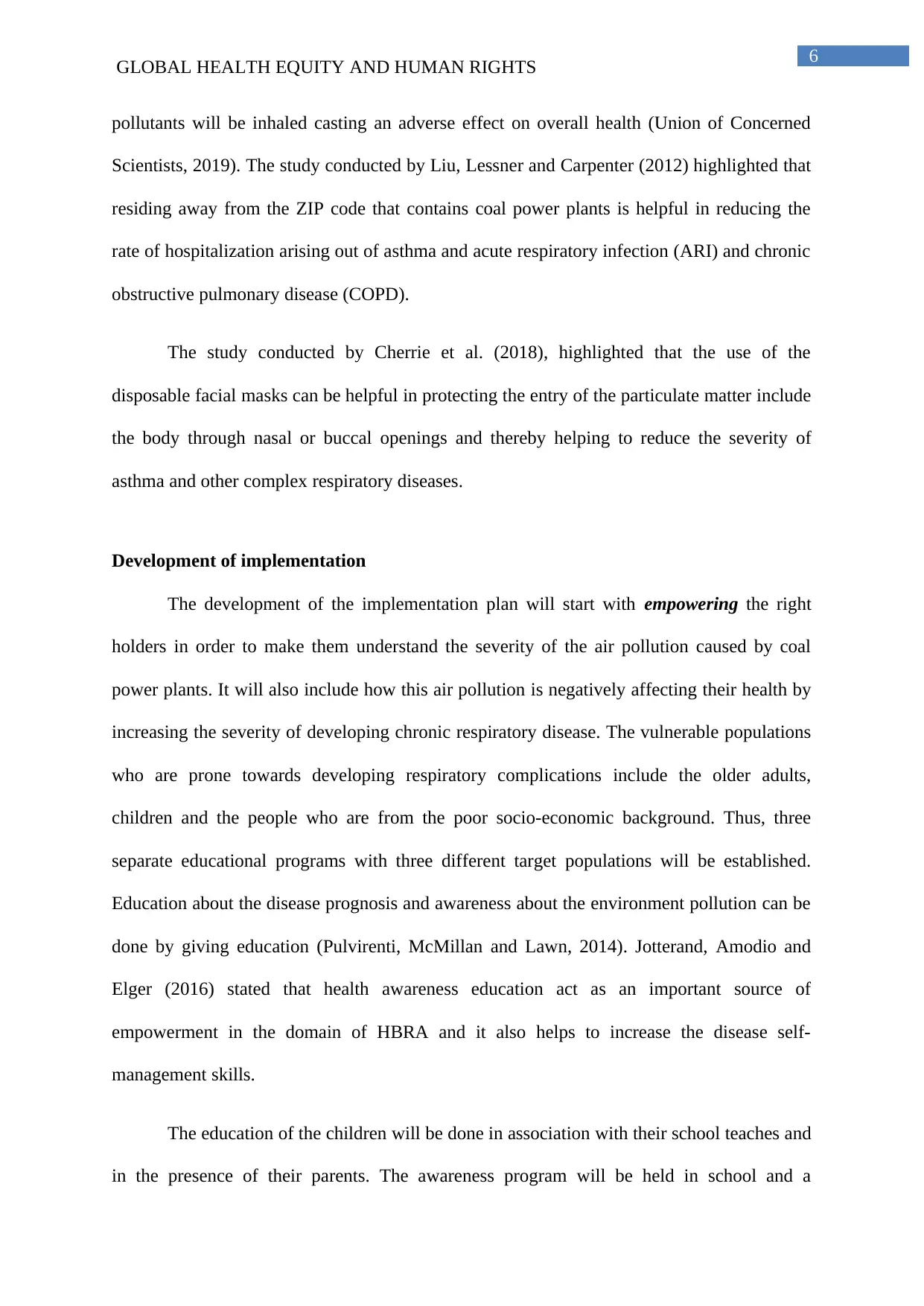
6
GLOBAL HEALTH EQUITY AND HUMAN RIGHTS
pollutants will be inhaled casting an adverse effect on overall health (Union of Concerned
Scientists, 2019). The study conducted by Liu, Lessner and Carpenter (2012) highlighted that
residing away from the ZIP code that contains coal power plants is helpful in reducing the
rate of hospitalization arising out of asthma and acute respiratory infection (ARI) and chronic
obstructive pulmonary disease (COPD).
The study conducted by Cherrie et al. (2018), highlighted that the use of the
disposable facial masks can be helpful in protecting the entry of the particulate matter include
the body through nasal or buccal openings and thereby helping to reduce the severity of
asthma and other complex respiratory diseases.
Development of implementation
The development of the implementation plan will start with empowering the right
holders in order to make them understand the severity of the air pollution caused by coal
power plants. It will also include how this air pollution is negatively affecting their health by
increasing the severity of developing chronic respiratory disease. The vulnerable populations
who are prone towards developing respiratory complications include the older adults,
children and the people who are from the poor socio-economic background. Thus, three
separate educational programs with three different target populations will be established.
Education about the disease prognosis and awareness about the environment pollution can be
done by giving education (Pulvirenti, McMillan and Lawn, 2014). Jotterand, Amodio and
Elger (2016) stated that health awareness education act as an important source of
empowerment in the domain of HBRA and it also helps to increase the disease self-
management skills.
The education of the children will be done in association with their school teaches and
in the presence of their parents. The awareness program will be held in school and a
GLOBAL HEALTH EQUITY AND HUMAN RIGHTS
pollutants will be inhaled casting an adverse effect on overall health (Union of Concerned
Scientists, 2019). The study conducted by Liu, Lessner and Carpenter (2012) highlighted that
residing away from the ZIP code that contains coal power plants is helpful in reducing the
rate of hospitalization arising out of asthma and acute respiratory infection (ARI) and chronic
obstructive pulmonary disease (COPD).
The study conducted by Cherrie et al. (2018), highlighted that the use of the
disposable facial masks can be helpful in protecting the entry of the particulate matter include
the body through nasal or buccal openings and thereby helping to reduce the severity of
asthma and other complex respiratory diseases.
Development of implementation
The development of the implementation plan will start with empowering the right
holders in order to make them understand the severity of the air pollution caused by coal
power plants. It will also include how this air pollution is negatively affecting their health by
increasing the severity of developing chronic respiratory disease. The vulnerable populations
who are prone towards developing respiratory complications include the older adults,
children and the people who are from the poor socio-economic background. Thus, three
separate educational programs with three different target populations will be established.
Education about the disease prognosis and awareness about the environment pollution can be
done by giving education (Pulvirenti, McMillan and Lawn, 2014). Jotterand, Amodio and
Elger (2016) stated that health awareness education act as an important source of
empowerment in the domain of HBRA and it also helps to increase the disease self-
management skills.
The education of the children will be done in association with their school teaches and
in the presence of their parents. The awareness program will be held in school and a
Paraphrase This Document
Need a fresh take? Get an instant paraphrase of this document with our AI Paraphraser
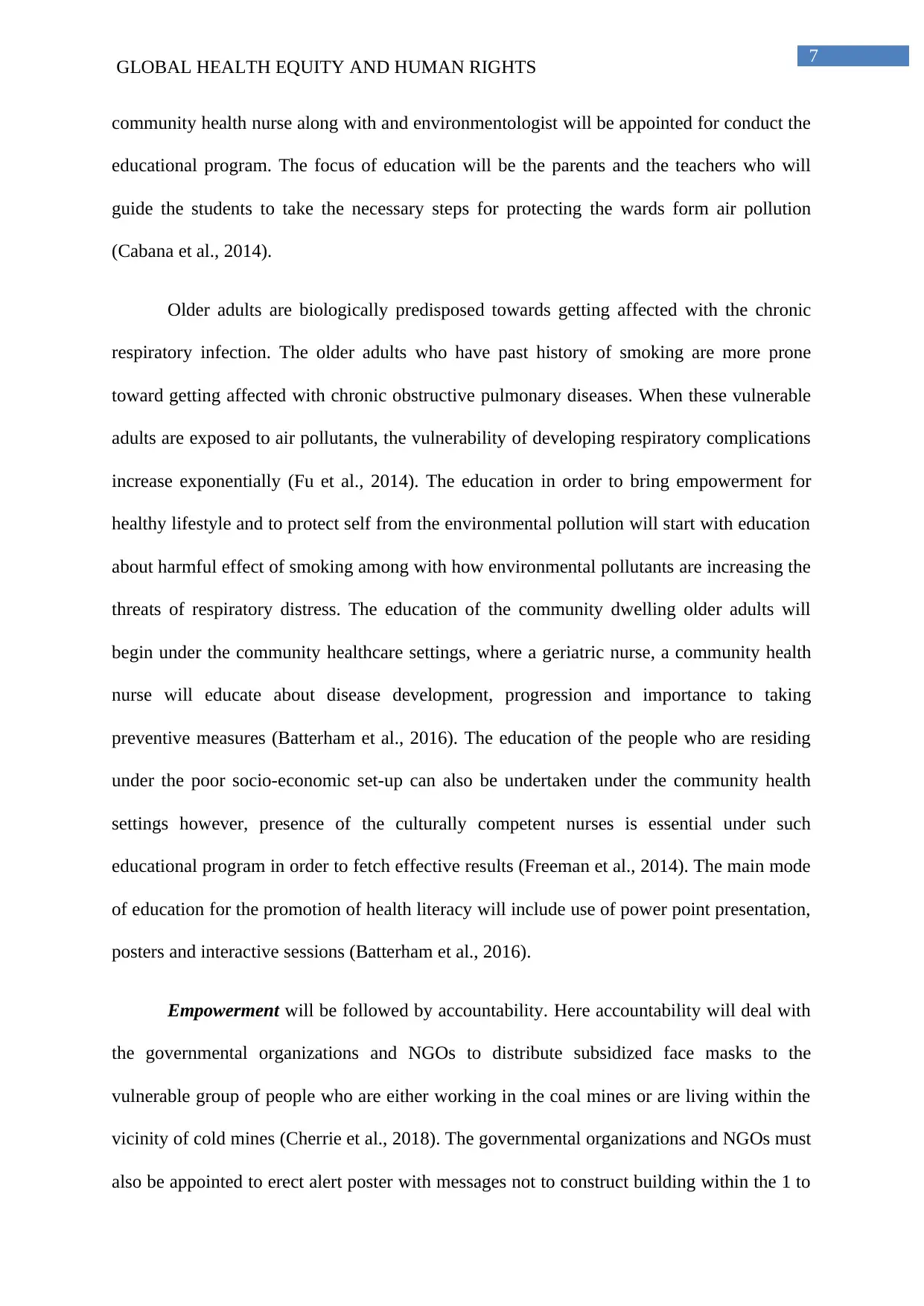
7
GLOBAL HEALTH EQUITY AND HUMAN RIGHTS
community health nurse along with and environmentologist will be appointed for conduct the
educational program. The focus of education will be the parents and the teachers who will
guide the students to take the necessary steps for protecting the wards form air pollution
(Cabana et al., 2014).
Older adults are biologically predisposed towards getting affected with the chronic
respiratory infection. The older adults who have past history of smoking are more prone
toward getting affected with chronic obstructive pulmonary diseases. When these vulnerable
adults are exposed to air pollutants, the vulnerability of developing respiratory complications
increase exponentially (Fu et al., 2014). The education in order to bring empowerment for
healthy lifestyle and to protect self from the environmental pollution will start with education
about harmful effect of smoking among with how environmental pollutants are increasing the
threats of respiratory distress. The education of the community dwelling older adults will
begin under the community healthcare settings, where a geriatric nurse, a community health
nurse will educate about disease development, progression and importance to taking
preventive measures (Batterham et al., 2016). The education of the people who are residing
under the poor socio-economic set-up can also be undertaken under the community health
settings however, presence of the culturally competent nurses is essential under such
educational program in order to fetch effective results (Freeman et al., 2014). The main mode
of education for the promotion of health literacy will include use of power point presentation,
posters and interactive sessions (Batterham et al., 2016).
Empowerment will be followed by accountability. Here accountability will deal with
the governmental organizations and NGOs to distribute subsidized face masks to the
vulnerable group of people who are either working in the coal mines or are living within the
vicinity of cold mines (Cherrie et al., 2018). The governmental organizations and NGOs must
also be appointed to erect alert poster with messages not to construct building within the 1 to
GLOBAL HEALTH EQUITY AND HUMAN RIGHTS
community health nurse along with and environmentologist will be appointed for conduct the
educational program. The focus of education will be the parents and the teachers who will
guide the students to take the necessary steps for protecting the wards form air pollution
(Cabana et al., 2014).
Older adults are biologically predisposed towards getting affected with the chronic
respiratory infection. The older adults who have past history of smoking are more prone
toward getting affected with chronic obstructive pulmonary diseases. When these vulnerable
adults are exposed to air pollutants, the vulnerability of developing respiratory complications
increase exponentially (Fu et al., 2014). The education in order to bring empowerment for
healthy lifestyle and to protect self from the environmental pollution will start with education
about harmful effect of smoking among with how environmental pollutants are increasing the
threats of respiratory distress. The education of the community dwelling older adults will
begin under the community healthcare settings, where a geriatric nurse, a community health
nurse will educate about disease development, progression and importance to taking
preventive measures (Batterham et al., 2016). The education of the people who are residing
under the poor socio-economic set-up can also be undertaken under the community health
settings however, presence of the culturally competent nurses is essential under such
educational program in order to fetch effective results (Freeman et al., 2014). The main mode
of education for the promotion of health literacy will include use of power point presentation,
posters and interactive sessions (Batterham et al., 2016).
Empowerment will be followed by accountability. Here accountability will deal with
the governmental organizations and NGOs to distribute subsidized face masks to the
vulnerable group of people who are either working in the coal mines or are living within the
vicinity of cold mines (Cherrie et al., 2018). The governmental organizations and NGOs must
also be appointed to erect alert poster with messages not to construct building within the 1 to
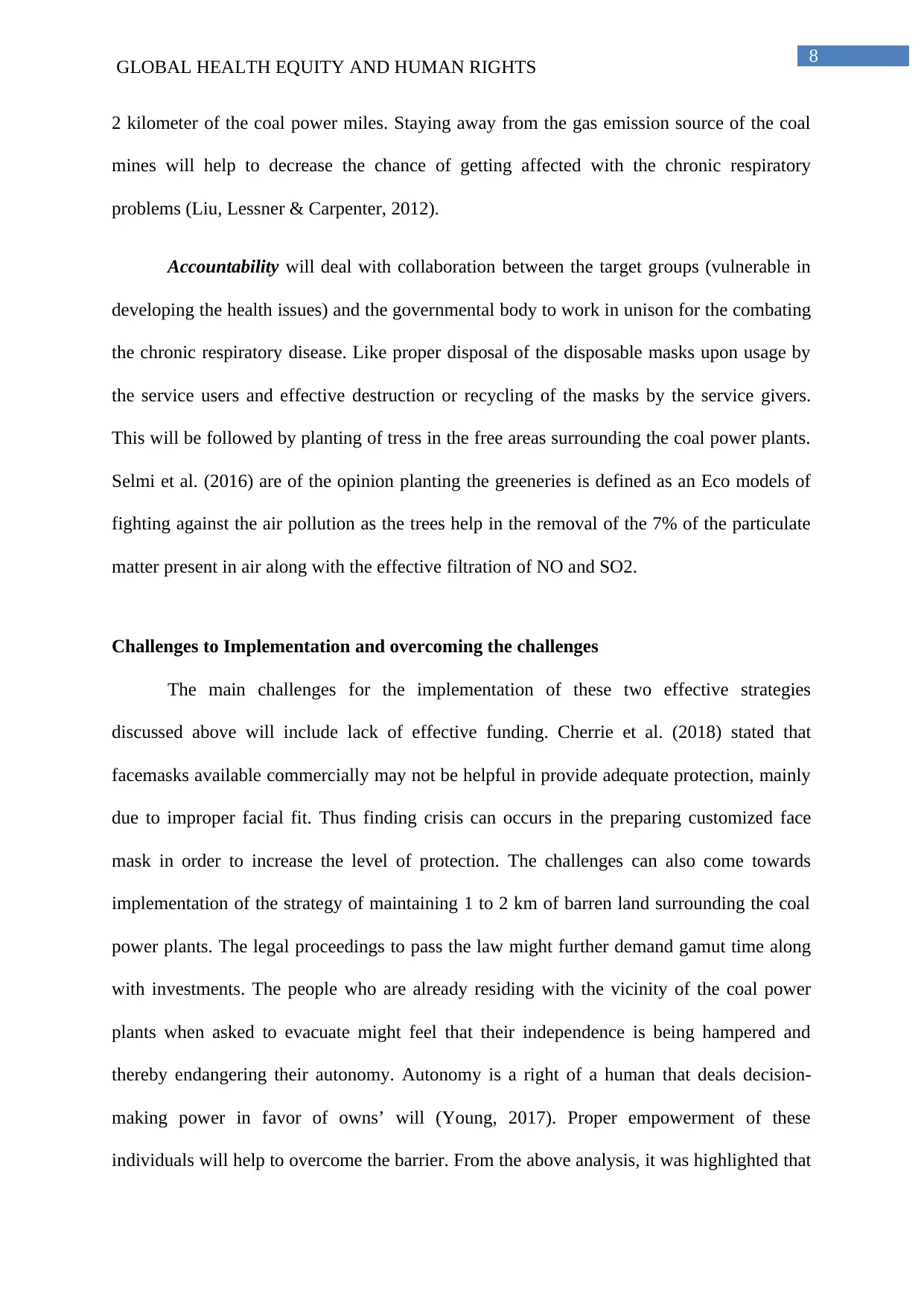
8
GLOBAL HEALTH EQUITY AND HUMAN RIGHTS
2 kilometer of the coal power miles. Staying away from the gas emission source of the coal
mines will help to decrease the chance of getting affected with the chronic respiratory
problems (Liu, Lessner & Carpenter, 2012).
Accountability will deal with collaboration between the target groups (vulnerable in
developing the health issues) and the governmental body to work in unison for the combating
the chronic respiratory disease. Like proper disposal of the disposable masks upon usage by
the service users and effective destruction or recycling of the masks by the service givers.
This will be followed by planting of tress in the free areas surrounding the coal power plants.
Selmi et al. (2016) are of the opinion planting the greeneries is defined as an Eco models of
fighting against the air pollution as the trees help in the removal of the 7% of the particulate
matter present in air along with the effective filtration of NO and SO2.
Challenges to Implementation and overcoming the challenges
The main challenges for the implementation of these two effective strategies
discussed above will include lack of effective funding. Cherrie et al. (2018) stated that
facemasks available commercially may not be helpful in provide adequate protection, mainly
due to improper facial fit. Thus finding crisis can occurs in the preparing customized face
mask in order to increase the level of protection. The challenges can also come towards
implementation of the strategy of maintaining 1 to 2 km of barren land surrounding the coal
power plants. The legal proceedings to pass the law might further demand gamut time along
with investments. The people who are already residing with the vicinity of the coal power
plants when asked to evacuate might feel that their independence is being hampered and
thereby endangering their autonomy. Autonomy is a right of a human that deals decision-
making power in favor of owns’ will (Young, 2017). Proper empowerment of these
individuals will help to overcome the barrier. From the above analysis, it was highlighted that
GLOBAL HEALTH EQUITY AND HUMAN RIGHTS
2 kilometer of the coal power miles. Staying away from the gas emission source of the coal
mines will help to decrease the chance of getting affected with the chronic respiratory
problems (Liu, Lessner & Carpenter, 2012).
Accountability will deal with collaboration between the target groups (vulnerable in
developing the health issues) and the governmental body to work in unison for the combating
the chronic respiratory disease. Like proper disposal of the disposable masks upon usage by
the service users and effective destruction or recycling of the masks by the service givers.
This will be followed by planting of tress in the free areas surrounding the coal power plants.
Selmi et al. (2016) are of the opinion planting the greeneries is defined as an Eco models of
fighting against the air pollution as the trees help in the removal of the 7% of the particulate
matter present in air along with the effective filtration of NO and SO2.
Challenges to Implementation and overcoming the challenges
The main challenges for the implementation of these two effective strategies
discussed above will include lack of effective funding. Cherrie et al. (2018) stated that
facemasks available commercially may not be helpful in provide adequate protection, mainly
due to improper facial fit. Thus finding crisis can occurs in the preparing customized face
mask in order to increase the level of protection. The challenges can also come towards
implementation of the strategy of maintaining 1 to 2 km of barren land surrounding the coal
power plants. The legal proceedings to pass the law might further demand gamut time along
with investments. The people who are already residing with the vicinity of the coal power
plants when asked to evacuate might feel that their independence is being hampered and
thereby endangering their autonomy. Autonomy is a right of a human that deals decision-
making power in favor of owns’ will (Young, 2017). Proper empowerment of these
individuals will help to overcome the barrier. From the above analysis, it was highlighted that
⊘ This is a preview!⊘
Do you want full access?
Subscribe today to unlock all pages.

Trusted by 1+ million students worldwide
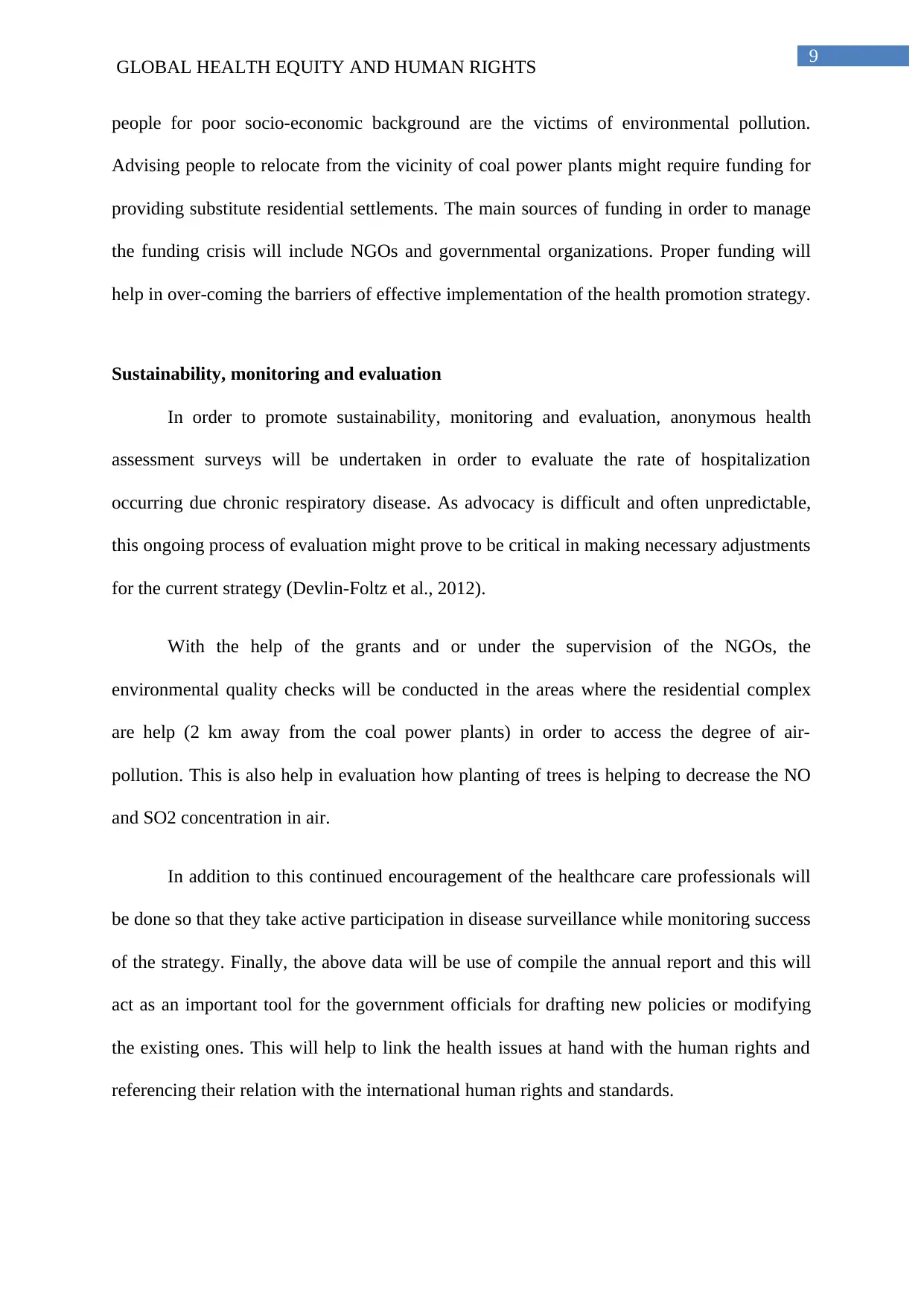
9
GLOBAL HEALTH EQUITY AND HUMAN RIGHTS
people for poor socio-economic background are the victims of environmental pollution.
Advising people to relocate from the vicinity of coal power plants might require funding for
providing substitute residential settlements. The main sources of funding in order to manage
the funding crisis will include NGOs and governmental organizations. Proper funding will
help in over-coming the barriers of effective implementation of the health promotion strategy.
Sustainability, monitoring and evaluation
In order to promote sustainability, monitoring and evaluation, anonymous health
assessment surveys will be undertaken in order to evaluate the rate of hospitalization
occurring due chronic respiratory disease. As advocacy is difficult and often unpredictable,
this ongoing process of evaluation might prove to be critical in making necessary adjustments
for the current strategy (Devlin-Foltz et al., 2012).
With the help of the grants and or under the supervision of the NGOs, the
environmental quality checks will be conducted in the areas where the residential complex
are help (2 km away from the coal power plants) in order to access the degree of air-
pollution. This is also help in evaluation how planting of trees is helping to decrease the NO
and SO2 concentration in air.
In addition to this continued encouragement of the healthcare care professionals will
be done so that they take active participation in disease surveillance while monitoring success
of the strategy. Finally, the above data will be use of compile the annual report and this will
act as an important tool for the government officials for drafting new policies or modifying
the existing ones. This will help to link the health issues at hand with the human rights and
referencing their relation with the international human rights and standards.
GLOBAL HEALTH EQUITY AND HUMAN RIGHTS
people for poor socio-economic background are the victims of environmental pollution.
Advising people to relocate from the vicinity of coal power plants might require funding for
providing substitute residential settlements. The main sources of funding in order to manage
the funding crisis will include NGOs and governmental organizations. Proper funding will
help in over-coming the barriers of effective implementation of the health promotion strategy.
Sustainability, monitoring and evaluation
In order to promote sustainability, monitoring and evaluation, anonymous health
assessment surveys will be undertaken in order to evaluate the rate of hospitalization
occurring due chronic respiratory disease. As advocacy is difficult and often unpredictable,
this ongoing process of evaluation might prove to be critical in making necessary adjustments
for the current strategy (Devlin-Foltz et al., 2012).
With the help of the grants and or under the supervision of the NGOs, the
environmental quality checks will be conducted in the areas where the residential complex
are help (2 km away from the coal power plants) in order to access the degree of air-
pollution. This is also help in evaluation how planting of trees is helping to decrease the NO
and SO2 concentration in air.
In addition to this continued encouragement of the healthcare care professionals will
be done so that they take active participation in disease surveillance while monitoring success
of the strategy. Finally, the above data will be use of compile the annual report and this will
act as an important tool for the government officials for drafting new policies or modifying
the existing ones. This will help to link the health issues at hand with the human rights and
referencing their relation with the international human rights and standards.
Paraphrase This Document
Need a fresh take? Get an instant paraphrase of this document with our AI Paraphraser
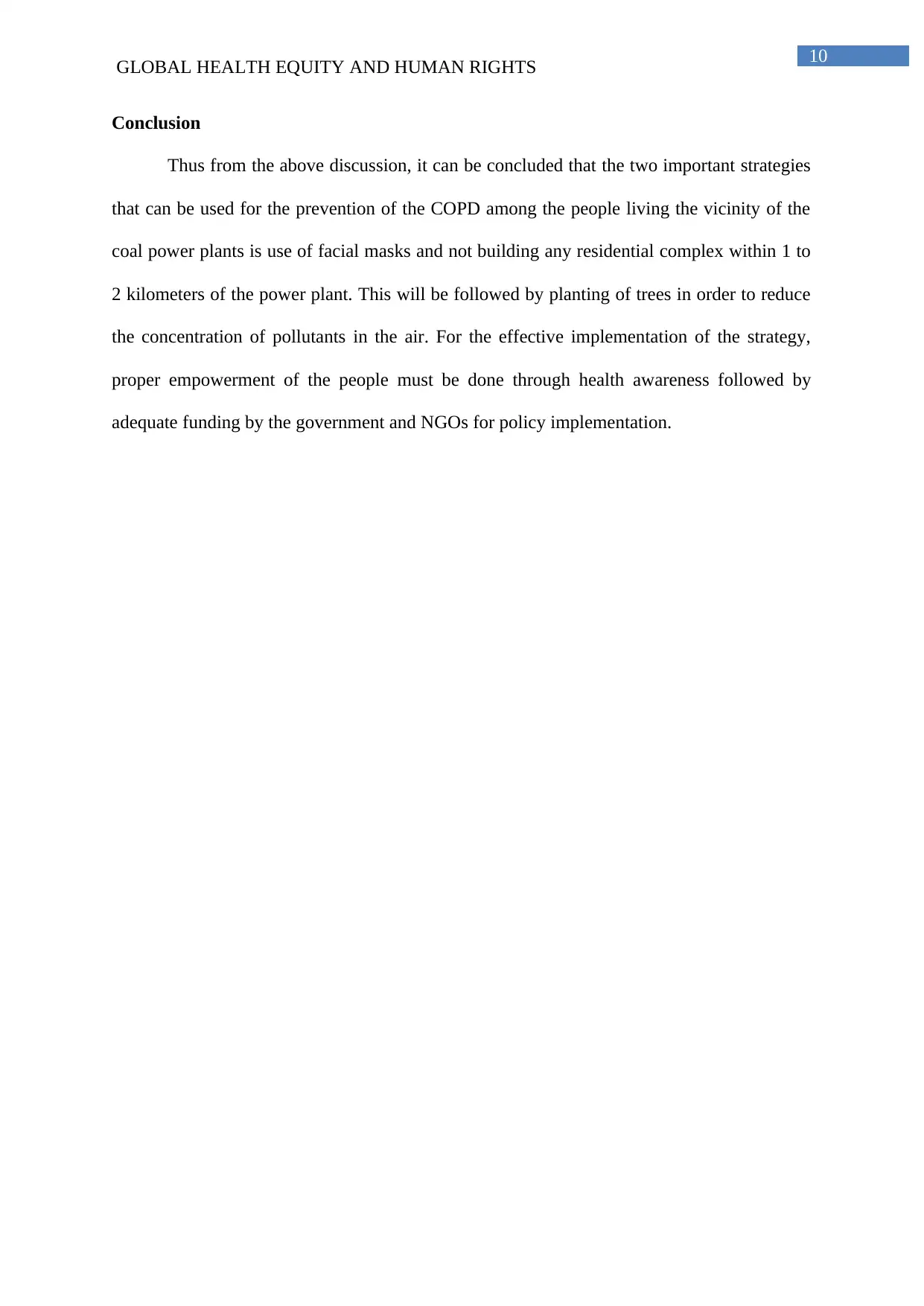
10
GLOBAL HEALTH EQUITY AND HUMAN RIGHTS
Conclusion
Thus from the above discussion, it can be concluded that the two important strategies
that can be used for the prevention of the COPD among the people living the vicinity of the
coal power plants is use of facial masks and not building any residential complex within 1 to
2 kilometers of the power plant. This will be followed by planting of trees in order to reduce
the concentration of pollutants in the air. For the effective implementation of the strategy,
proper empowerment of the people must be done through health awareness followed by
adequate funding by the government and NGOs for policy implementation.
GLOBAL HEALTH EQUITY AND HUMAN RIGHTS
Conclusion
Thus from the above discussion, it can be concluded that the two important strategies
that can be used for the prevention of the COPD among the people living the vicinity of the
coal power plants is use of facial masks and not building any residential complex within 1 to
2 kilometers of the power plant. This will be followed by planting of trees in order to reduce
the concentration of pollutants in the air. For the effective implementation of the strategy,
proper empowerment of the people must be done through health awareness followed by
adequate funding by the government and NGOs for policy implementation.
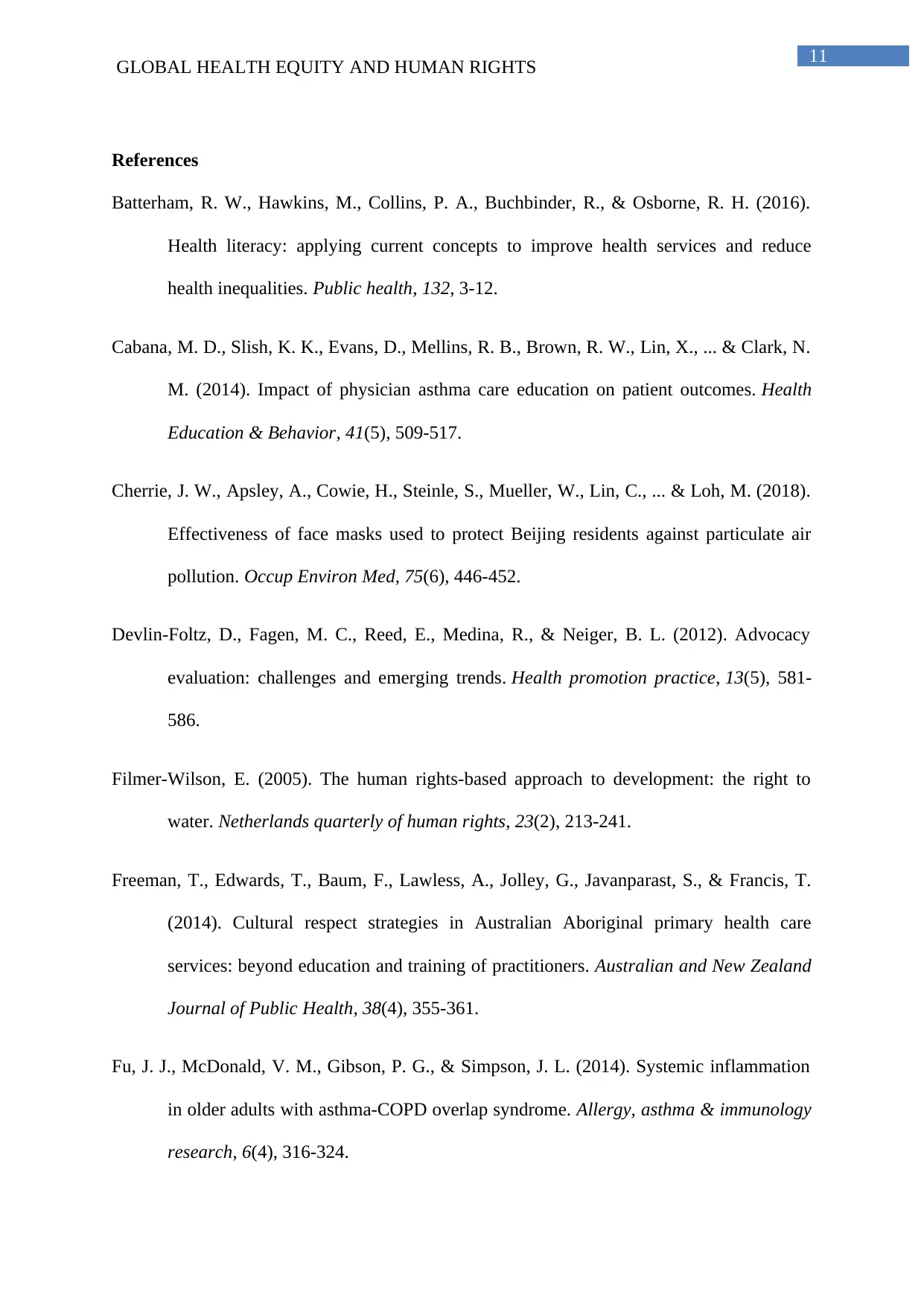
11
GLOBAL HEALTH EQUITY AND HUMAN RIGHTS
References
Batterham, R. W., Hawkins, M., Collins, P. A., Buchbinder, R., & Osborne, R. H. (2016).
Health literacy: applying current concepts to improve health services and reduce
health inequalities. Public health, 132, 3-12.
Cabana, M. D., Slish, K. K., Evans, D., Mellins, R. B., Brown, R. W., Lin, X., ... & Clark, N.
M. (2014). Impact of physician asthma care education on patient outcomes. Health
Education & Behavior, 41(5), 509-517.
Cherrie, J. W., Apsley, A., Cowie, H., Steinle, S., Mueller, W., Lin, C., ... & Loh, M. (2018).
Effectiveness of face masks used to protect Beijing residents against particulate air
pollution. Occup Environ Med, 75(6), 446-452.
Devlin-Foltz, D., Fagen, M. C., Reed, E., Medina, R., & Neiger, B. L. (2012). Advocacy
evaluation: challenges and emerging trends. Health promotion practice, 13(5), 581-
586.
Filmer-Wilson, E. (2005). The human rights-based approach to development: the right to
water. Netherlands quarterly of human rights, 23(2), 213-241.
Freeman, T., Edwards, T., Baum, F., Lawless, A., Jolley, G., Javanparast, S., & Francis, T.
(2014). Cultural respect strategies in Australian Aboriginal primary health care
services: beyond education and training of practitioners. Australian and New Zealand
Journal of Public Health, 38(4), 355-361.
Fu, J. J., McDonald, V. M., Gibson, P. G., & Simpson, J. L. (2014). Systemic inflammation
in older adults with asthma-COPD overlap syndrome. Allergy, asthma & immunology
research, 6(4), 316-324.
GLOBAL HEALTH EQUITY AND HUMAN RIGHTS
References
Batterham, R. W., Hawkins, M., Collins, P. A., Buchbinder, R., & Osborne, R. H. (2016).
Health literacy: applying current concepts to improve health services and reduce
health inequalities. Public health, 132, 3-12.
Cabana, M. D., Slish, K. K., Evans, D., Mellins, R. B., Brown, R. W., Lin, X., ... & Clark, N.
M. (2014). Impact of physician asthma care education on patient outcomes. Health
Education & Behavior, 41(5), 509-517.
Cherrie, J. W., Apsley, A., Cowie, H., Steinle, S., Mueller, W., Lin, C., ... & Loh, M. (2018).
Effectiveness of face masks used to protect Beijing residents against particulate air
pollution. Occup Environ Med, 75(6), 446-452.
Devlin-Foltz, D., Fagen, M. C., Reed, E., Medina, R., & Neiger, B. L. (2012). Advocacy
evaluation: challenges and emerging trends. Health promotion practice, 13(5), 581-
586.
Filmer-Wilson, E. (2005). The human rights-based approach to development: the right to
water. Netherlands quarterly of human rights, 23(2), 213-241.
Freeman, T., Edwards, T., Baum, F., Lawless, A., Jolley, G., Javanparast, S., & Francis, T.
(2014). Cultural respect strategies in Australian Aboriginal primary health care
services: beyond education and training of practitioners. Australian and New Zealand
Journal of Public Health, 38(4), 355-361.
Fu, J. J., McDonald, V. M., Gibson, P. G., & Simpson, J. L. (2014). Systemic inflammation
in older adults with asthma-COPD overlap syndrome. Allergy, asthma & immunology
research, 6(4), 316-324.
⊘ This is a preview!⊘
Do you want full access?
Subscribe today to unlock all pages.

Trusted by 1+ million students worldwide
1 out of 14
Your All-in-One AI-Powered Toolkit for Academic Success.
+13062052269
info@desklib.com
Available 24*7 on WhatsApp / Email
![[object Object]](/_next/static/media/star-bottom.7253800d.svg)
Unlock your academic potential
Copyright © 2020–2025 A2Z Services. All Rights Reserved. Developed and managed by ZUCOL.
